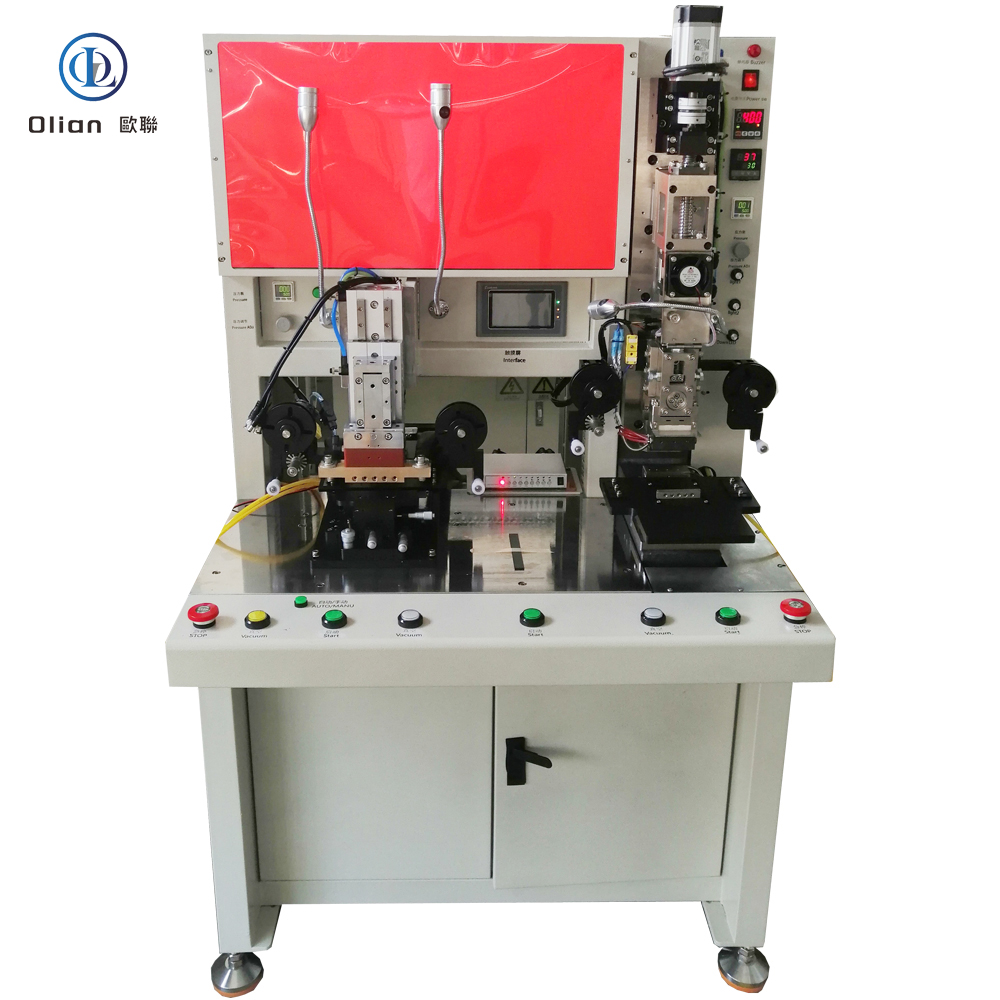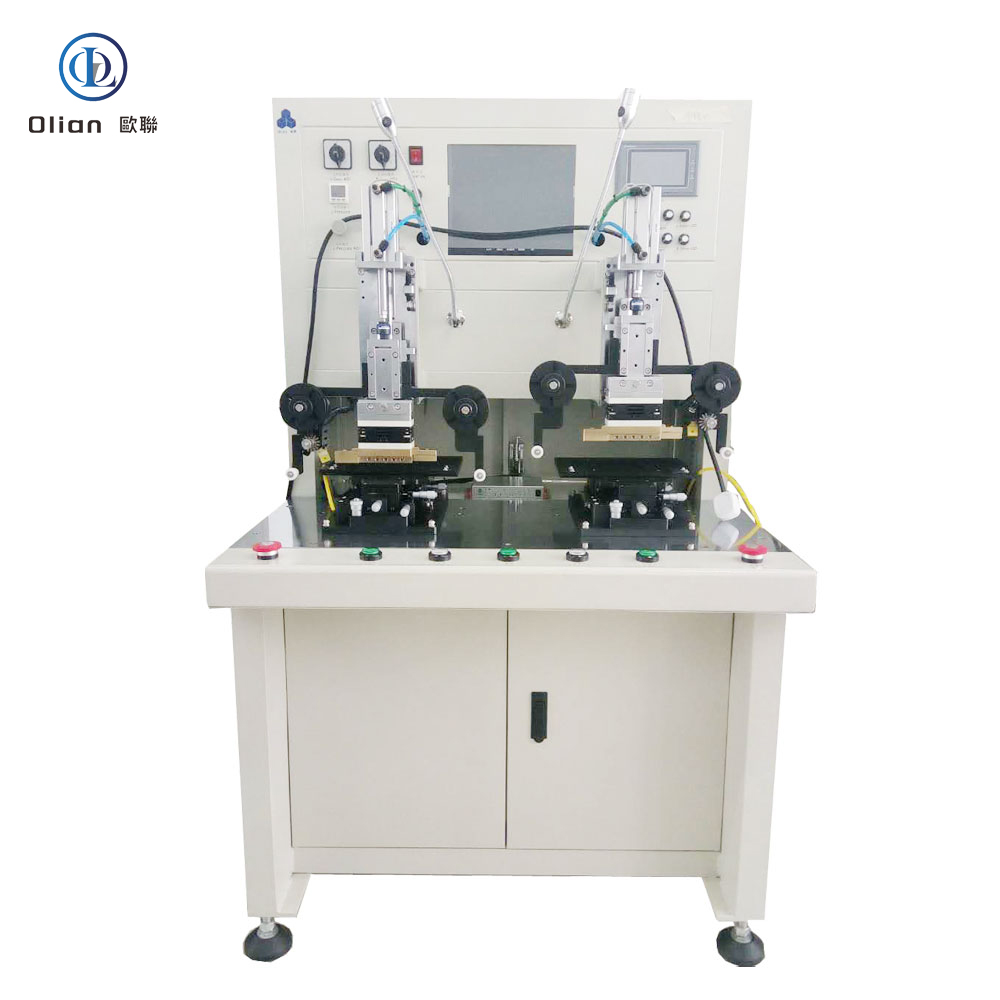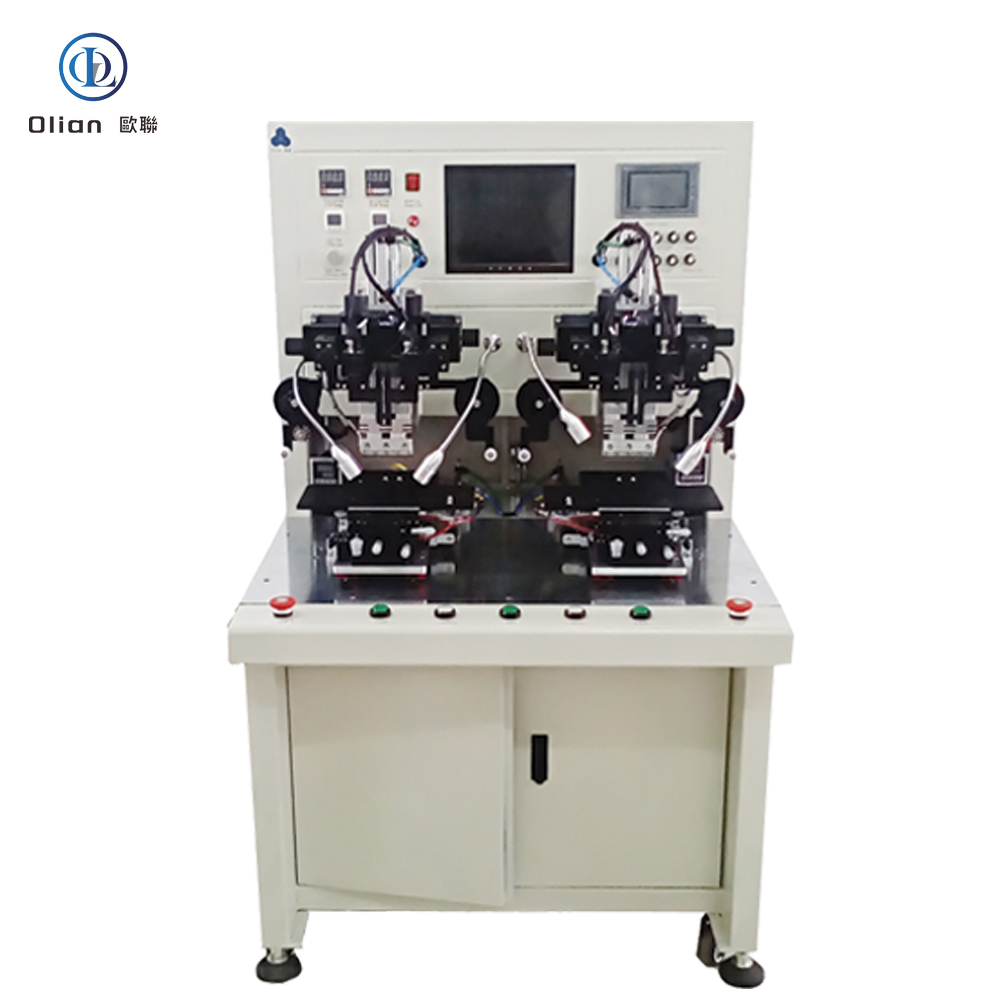

OL-FC005 – 7-Inch Dual-Station Pre-Bond Main Bond Integrated COF FOG Machine

The OL-FC005 by Olian Automatic is an integrated dual-station COF(chip on film) FOG (Film-on-Glass) bonding system that combines pre-bonding and main bonding in a single machine. The left station performs pulse pre-bonding to temporarily tack flexible circuits (FPC or COF) onto LCD panels, while the right station executes full main bonding to permanently cure the joint—streamlining workflow and reducing handling errors.
The machine assumes that anisotropic conductive film (ACF) has already been pre-applied to the panel or FPC. It does not apply ACF, nor does it support IC chip bonding.
Operators first align and pre-bond the panel on the left, then transfer it directly to the right station for final bonding—enabling efficient, two-step processing without leaving the workstation.
Both stations use a single lower-view microscope for alignment. The operator places the panel on a transparent glass stage and views terminal marks from below. The COF /FPC is positioned manually from above using visual estimation.
This “lower-only” method provides a practical balance of simplicity and accuracy for mid-precision applications.
Both stations feature independent temperature and time settings to optimize pre-tack and main-cure profiles separately.
Each station includes an automatic buffer tape feed system to protect the FPC during pressing:
Two independent buffer systems ensure reliable protection at both pre-bond and main bond stages.
All parameters—temperature, time, pressure—are set independently for each station via the HMI.
The compact footprint integrates seamlessly into production lines or R&D labs.
Ideal for two-stage bonding of:
Commonly used where process control, reduced contamination, and workflow efficiency are critical.
Olian Automatic provides comprehensive post-sale support:
Model: OL-FC005
Type: Integrated Dual-Station COF /FOG Machine (Pre-Bond + Main Bond)
Layout: Left = Pre-Bond | Right = Main Bond
Max Panel Size: 7 inches (rigid glass)
Key Advantage: Streamlined two-step bonding in one workstation
SEO Keywords:
Integrated pre-bond and main bond machine, OL-FC005, Olian Automatic dual-function COF FOG bonder, 7-inch left pre-right main bonding system, COF FPC tacking and curing workstation, two-station COF FOG machine with buffer feed, manual COF FOG bonder with pre-main integration, lower-view alignment COF FOG equipment, ACF bonding system for display assembly, dual-station pulse and thermal compression bonder.


The OL-FP003 by Olian Automatic is a dual-station manual pulse pre-bonding machine designed for temporary tacking of flexible printed circuits (FPC) or touch sensor flexes onto rigid LCD panels up to 7 inches. This system uses short-duration pulse heating to lightly cure anisotropic conductive film (ACF), holding the FPC in place before final main bonding.
The machine assumes that ACF has already been pre-applied to the panel or FPC. It performs pre-bonding only—not full main bonding—and does not support IC, COF, or ACF lamination functions.
The OL-FP003 employs a single lower-view microscope for alignment. The operator places the panel on a transparent glass stage and views terminal marks from below through the microscope. The FPC is then positioned manually from above using visual estimation.
This “lower-only” method provides a simple, cost-effective solution for applications where moderate alignment accuracy is sufficient.
The machine features two identical, fully independent stations arranged side by side. Each includes:
Operators can alternate between stations for continuous workflow, improving efficiency in small-batch or R&D environments.
The cycle is semi-automatic—alignment is manual, but heating and pressing are controlled and repeatable.
Rapid-response cartridge heaters enable precise thermal pulses ideal for ACF tacking without over-curing.
An integrated buffer tape feed system protects the FPC during pressing:
All key parameters—temperature, time, pressure—are set via the HMI for consistent pre-bond quality.
Compact and robust, suitable for cleanrooms, pilot lines, and repair workshops.
Ideal for pre-bonding:
Commonly used in display assembly, prototyping labs, and low-volume production.
Olian Automatic provides comprehensive post-sale support:
Model: OL-FP003
Function: Manual Pulse Pre-Bonding Only
Max Panel Size: 7 inches (rigid glass)
Alignment: Lower-side microscope only
Key Advantage: Dual-station efficiency with simple, reliable pre-tacking
SEO Keywords:
Pulse bonding machine, OL-FP003, Olian Automatic FPC bonder, 7-inch dual-station bond press, lower-view alignment bonder, manual FOG tacking system, thermal pulse machine for ACF, FPC tacking equipment for LCD, economical bond workstation, fixed-platform pulse bonder.


The OL-F0715 by Olian Automatic is a dual-station manual FOG (Film-on-Glass) bonding machine designed for thermal compression of flexible printed circuits (FPC) or touch sensor flexes onto rigid LCD panels up to 7 inches. This model features an extended 150 mm press head, enabling bonding of wide FPCs or multiple connectors in a single stroke—ideal for automotive displays, industrial HMIs, and large-flex applications.
The system assumes that anisotropic conductive film (ACF) has already been pre-applied to the panel or FPC. It performs main bonding only, fully curing the ACF joint under controlled heat, pressure, and time. It does not apply ACF, nor does it support IC or COF chip bonding.
The OL-F0715 uses a single lower-view microscope for alignment. The operator places the panel on a transparent glass stage and views terminal marks from below through the microscope. The FPC is then positioned manually from above using visual estimation and experience.
This “lower-only” alignment approach is straightforward, robust, and well-suited for production environments where FPC pads are sufficiently large or where moderate alignment tolerance is acceptable.
A key differentiator of the OL-F0715 is its 150 mm long press head, significantly longer than standard 60 mm heads. This allows:
The head thickness is 1.0 mm, and custom dimensions are available upon request.
The machine includes two identical, fully independent stations arranged side by side. Each station features:
Operators can alternate between stations for continuous workflow, maximizing uptime in small-batch or pilot-line production.
The thermal cycle is fully automated once initiated, ensuring consistent results.
Heating is achieved via high-efficiency cartridge heaters, with temperature monitored by industrial-grade sensors for process stability.
An integrated buffer tape feed system protects the FPC during pressing:
All critical parameters—temperature, time, pressure—are configured via the HMI for repeatability across shifts.
The compact footprint integrates easily into cleanrooms or production lines.
Ideal for bonding:
Commonly used in automotive electronics, medical displays, and heavy-equipment HMI manufacturing.
Olian Automatic provides full lifecycle support:
Model: OL-F0715
Type: Dual-Station Manual FOG Main Bonding Machine
Key Feature: 150 mm extended press head
Alignment: Lower-side microscope only
Max Panel Size: 7 inches (rigid glass)
SEO Keywords:
150mm FOG bonding machine, OL-F0715, Olian Automatic wide-head FPC bonder, 7-inch dual-station FOG press with long hot bar, manual FPC to glass bonding equipment, extended press head FOG machine, thermal compression bonder for wide flex, lower-view alignment FOG workstation, main bonding machine for automotive displays, 150mm hot bar FOG system.

OL-F003 – 7-Inch Dual-Station Manual FOG Bonding Machine with Lower-Side Fixed Alignment

The OL-F003 by Olian Automatic is a dual-station manual FOG (Film-on-Glass) bonding machine designed for thermal compression of flexible printed circuits (FPC) or touch sensor flexes onto rigid LCD panels up to 7 inches. This system uses lower-side visual alignment only, where operators view panel terminals from below through a single microscope while manually positioning the FPC from above.
The machine assumes that anisotropic conductive film (ACF) has already been pre-applied to either the panel or the FPC. It performs main bonding only—fully curing the ACF joint under heat and pressure. It does not apply ACF, nor does it support IC or COF bonding.
Unlike dual-lens systems, the OL-F003 employs a single lower-view microscope. The operator places the panel on a transparent glass stage. They look through the microscope from below to see the panel’s terminal marks. Then, they manually place and adjust the FPC from above using visual estimation and experience.
This “lower-only” method is simple, cost-effective, and suitable for applications where ultra-high precision is not required or where FPC pads are large enough for manual placement tolerance.
The machine features two identical, fully independent bonding stations side by side. Each station includes:
Operators can work on one station while the other is idle, enabling continuous production. All loading, unloading, and alignment are performed manually at the front.
The entire bonding cycle is semi-automatic—alignment is manual, but pressing is controlled and repeatable.
Heating is delivered via embedded cartridge heaters, monitored by K-type thermocouples for stable thermal control.
An integrated buffer tape feed system protects the FPC during bonding:
All critical parameters—temperature, time, pressure—are set via the HMI for consistent results.
Compact footprint suits cleanrooms, pilot lines, and repair workshops.
Suitable for bonding:
Commonly used in:
Olian Automatic provides complete post-sale support:
Model: OL-F003
Type: Dual-Station Manual FOG Bonding Machine
Alignment: Lower-side microscope only
Max Panel Size: 7 inches (rigid glass)
Core Advantage: Simple, reliable, cost-effective manual bonding with dual-station throughput
SEO Keywords:
FOG bonding machine, OL-F003, Olian Automatic manual FPC bonder, 7-inch dual-station FOG press, single-microscope FOG machine, manual FPC to glass bonding equipment, thermal compression bonder for IN-CELL flex, fixed-alignment FOG workstation, economical FOG bonding system, main bonding machine with lower-side vision.


The OL-FP005 by Olian Automatic is a dual-station manual pulse pre-bonding machine designed for precise thermal tacking of flexible printed circuits (FPC) or touch sensor flexes onto rigid LCD panels up to 7 inches. This system enables operators to perform high-accuracy pre-bonding—a critical step that temporarily fixes FPCs in place and final main bonding.
The machine assumes that anisotropic conductive film (ACF) has already been applied to the panel or FPC. It does not apply ACF, nor does it perform main bonding, IC attachment, or COF processing.
bonding ensures the FPC remains aligned during transfer to the main bonder. The OL-FP005 uses short-duration pulse heating to lightly cure the ACF without full compression—just enough to hold position. This is distinct from main bonding and requires lower energy and shorter time.
The OL-FP005 features two identical, fully independent stations arranged side by side. Each includes:
Operators can alternate between stations for continuous workflow, or two technicians can work simultaneously—doubling throughput in small-batch production or R&D environments.
Alignment is achieved through a dual-optical-path microscope that provides simultaneous views of the panel terminals (from below) and FPC pads (from above) on a single split-screen monitor.
Key optical specifications:
The operator places the panel on the lower stage and activates vacuum. They then position the FPC on the upper stage. Using manual X-Y adjustment knobs, they shift the panel until fiducial marks align perfectly on screen—ensuring micron-level accuracy before pre-bonding.
After alignment, the operator initiates the cycle. The entire bonding platform automatically moves forward into the press zone. The heated head descends, applies a brief pulse of heat and light pressure, then retracts. The platform then returns backward to the original loading position—keeping the operator’s hands safely away from hot components during actuation.
Heating is delivered via high-response cartridge elements, enabling rapid thermal pulses ideal for pre-tacking ACF without over-curing.
The machine includes an automatic buffer tape feed system to protect the FPC during pressing:
Ideal for pre-bonding:
Commonly used in:
Olian Automatic provides full lifecycle support:
Model: OL-FP005
Function: Manual Pulse Pre-Bonding Only
Max Panel Size: 7 inches (rigid glass)
Key Innovation: Dual-lens upper-lower alignment + front-rear motion + dual stations
Operation: Manual alignment, semi-automatic pulse cycle
SEO Keywords:
Pulse bonding machine, OL-FP005, Olian Automatic FPC bonder, 7-inch dual-station bond press, manual FOG bonding equipment, upper-lower alignment bonder, split-screen vision bond machine, FPC tacking system for LCD, thermal pulse bonder for touch flex, dual-lens pre-alignment workstation.

OL-F006 – 7-Inch Dual-Station Manual FOG Bonding Machine with Dual-Lens Upper-Lower Alignment

The OL-F006 by Olian Automatic is a high-precision manual FOG (Fpc-on-Glass) bonding machine designed for thermal compression of flexible printed circuits (FPC) or touch sensor flexes onto rigid LCD panels up to 7 inches. Featuring dual independent workstations, this system enables efficient, repeatable bonding for small-batch production, pilot lines, and display repair applications.
Unlike standard bonders, the OL-F006 integrates simultaneous upper-lower optical alignment with front-rear platform motion, allowing operators to achieve micron-level accuracy through direct visual matching of panel and FPC fiducial marks—without automated vision software.
This machine performs final main bonding only. It assumes that anisotropic conductive film (ACF) has already been pre-laminated onto either the glass panel or the FPC. The OL-F006 does not apply ACF, nor does it support IC or COF bonding. Its sole purpose is the thermal curing of pre-aligned FPC-to-glass or touch-flex-to-glass assemblies.
The OL-F006 features two identical, fully independent bonding stations arranged side by side. Each station includes its own:
Operators can work on both stations alternately to maximize throughput, or two technicians can operate simultaneously. All loading, unloading, and alignment are performed manually at the front of the machine.
The heart of the OL-F006 is its dual optical path alignment system. Two high-resolution lenses—one viewing the panel from below, the other viewing the FPC from above—project real-time images onto a single split-screen monitor. This allows the operator to see both sets of alignment marks simultaneously.
Key optical specs:
The operator places the panel on the lower glass stage and activates vacuum hold. They then position the FPC on the upper stage. Using manual X-Y adjustment knobs beneath the panel stage, they shift the glass until the panel marks align perfectly with the FPC marks on screen. This “upper-lower” visual method ensures high alignment fidelity without complex software calibration.
Once alignment is confirmed:
This front-rear motion keeps the operator’s hands safely away from the hot zone during pressing while maintaining ergonomic access during setup.
Heating is achieved via embedded cartridge heaters, with temperature monitored by industrial-grade sensors to ensure process stability.
The machine includes an integrated buffer tape feeding system to protect the FPC during bonding:
All critical parameters—temperature, time, pressure—are set and monitored via the HMI, ensuring consistent results across shifts and operators.
The compact footprint fits easily into most cleanroom or workshop environments.
Ideal for bonding:
Commonly used in:
Olian Automatic provides comprehensive post-sale support:
Model: OL-F006
Type: Dual-Station Manual FOG Main Bonding Machine
Max Panel Size: 7 inches (rigid glass)
Core Innovation: Upper-lower dual-lens visual alignment + front-rear platform motion
Operation: Manual alignment, semi-automatic bonding cycle
SEO Keywords:
Dual-station FOG bonding machine, OL-F006, Olian Automatic manual FPC bonder, 7-inch Film-on-Glass press with dual-lens alignment, upper-lower mark alignment system, front-rear motion FOG machine, manual FPC to glass bonding equipment, thermal compression bonder for touch flex, high-precision manual FOG workstation, split-screen vision FOG press.